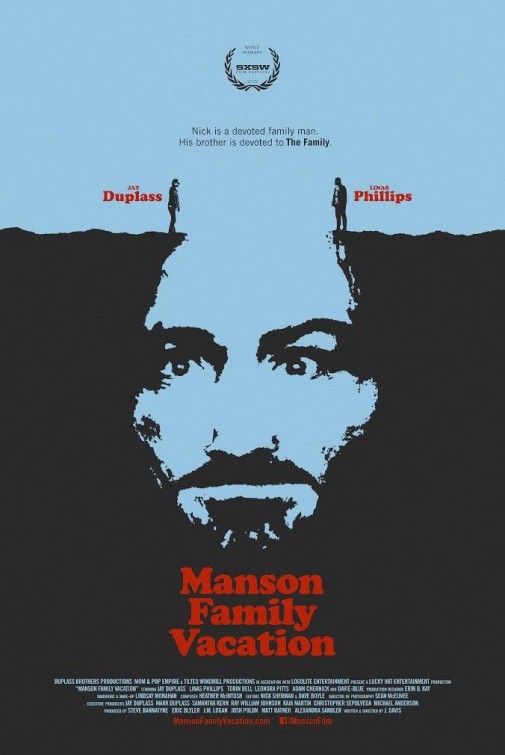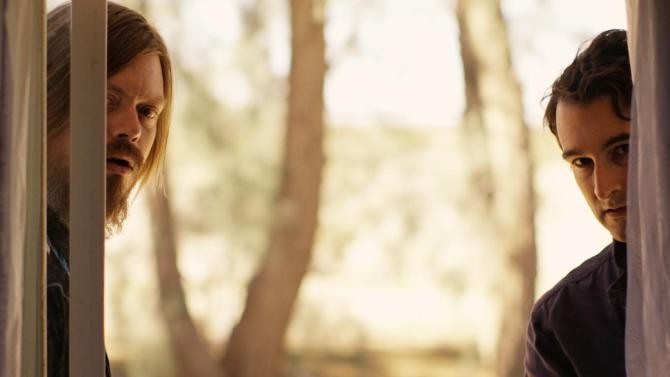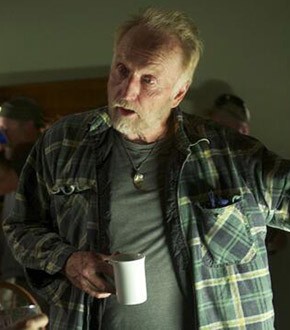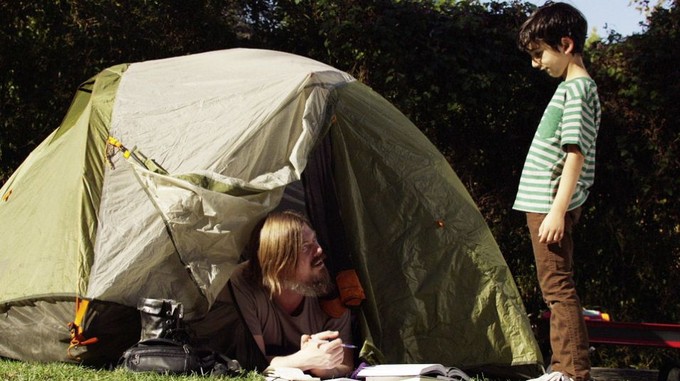
When you first hear the title “MANSON FAMILY VACATION”, you probably have something of an idea of what to expect. Whether you expect something comical or horrific, the title most likely conjures up horrible images of messages smeared in blood and young, innocent people dying horrible deaths.
There’s none of that in this film.
J. Davis’ debut as a writer/director after years of working as an editor is a story about two brothers (played by Jay Duplass and Linas Phillips) reconnecting after a long estrangement. Jay’s character, Nick, is a family man who thinks of Phillips’ Conrad as something of an untethered loser even before Conrad reveals a newfound obsession with Charles Manson. As a sort of attempt at bonding, Conrad pushes Nick to take him to sites in and around Los Angeles that are landmarks of Manson and the cult he designed around himself. Eventually, they end up meeting a correspondent of Manson’s (played by SAW’s Tobin Bell) and get to the true source of Conrad’s fascination with the incarcerated serial killer.
Davis creates a loose, improvisational feel that nonetheless manages to evoke the pathos and intimacy necessary for the ultimate conclusion to have a significant impact. I spoke with him and Mr. Bell together, and they talked about how they added depth to these characters and how a small independent film can end up as ambitious and nuanced as anything else:

VINYARD: This is your first movie as a director, you’re mostly an editor. What led you to writing this script? What was the inspiration that made you need to get this story out?
TOBIN: He likes old busses.
DAVIS: It was sort of after I had edited a documentary for Jay (Duplass). I began thinking about writing a screenplay, and threw out a few ideas at him, and he went, “I feel heat coming off that one.” So that was the one I pursued. He was also kind of repulsed by the idea as well, which is why eventually I asked him to play the part of this brother who’s repulsed.
TOBIN: Repulsed by the idea, perfect. How many times did you see the film?
VINYARD: Once, just the once.
TOBIN: When’d you see it?
VINYARD: A couple of nights ago. Jay is acting in the movie, he’s not doing anything creatively besides producing. I’m curious what was his role on set?
DAVIS: He kinda encouraged me all along the way and gave notes all along the way, then he and Linas (Phillips) brought their characters and worked out their backstories, as did Tobin, and made their characters come to life.
TOBIN: J. David carried a lasso on the set to keep everyone from getting too far outfield.
DAVIS: (laughs) Yeah, we’d do scenes often and get the scene in the can, and then we might improvise a bit because everyone was so comfortable in their characters that it seemed like a good idea to do some exploring.
VINYARD: How did you guys talk about your backstories? Did you come up with them on your own or did you have tete-a-tetes?
DAVIS: You worked out your backstory kind of on your own.
TOBIN: It was very simple. His backstory was that he was in the can with Charlie, and he met him there, and Charlie was straight up…with me. That’s all you really care about when you’re in prison. ’Cause everyone’s done something horrible, so if someone is straightforward and respectful…all we did was play cards. I never had any problem with Charlie. I was on my way out the door, he said, “Where you goin’?” I said, “I got family in Fresno, and I thought I might go up there, but I don’t really like them and they don’t really like me.” He says, “There’s this piece of property over there that I don’t think anyone’s living in. If you don’t have anyplace to go, here’s the coordinates.” That’s basically the backstory, and it went on from there.
DAVIS: With Jay and Linas, we worked for a long time going through the script together and really working out their backstories way before we were in production. To kind of answer an earlier question, I was a firsttime director, so it was nice for me to have people who have more experience. Jay is a director, Linas is a director- that’s why I had gotten interested in him, because I liked his directing work. Both of my editors were directors: Nick Sherman, who I cut a documentary for, Dave Boyle, who’s an independent filmmaker. Even our poster artist, Yen Tan, is a director. So I kind of surrounded myself with a lot of directors so that I could ask their opinions on things.
TOBIN: It shows in the first two minutes of the film. Those tweaks you made to the first two minutes of the film, rhythm-wise. You can tell that whoever did that knew how to make it better. It wasn’t just different, it was better. It was the same, but BETTER.
DAVIS: I was incredibly lucky to be able to pull all these people onto this project.
TOBIN: Film’s such a collaborative enterprise. The best people take a little from that person and a little from that person, because you can’t do it all yourself.

VINYARD: Oddly enough, you’re not credited as an editor. I think every movie you’ve worked on before this you’re part of the editing crew or you’re the primary editor. How involved were you in the editing?
DAVIS: I did a bit of editing on it, but I feel like I ended being able to pull myself back from the editing more than I ever thought I would because the editors were so good.
VINYARD: It’s your first movie, it’s almost like your first baby. You weren’t nervous about putting it in someone else’s hands?
DAVIS: For instance, David Boyle showed me a cut of a scene at one point, and I looked at it and went home and said, “My first note is we should take three frames off the end of this shot.” And he went, “You know what? I already took exactly three frames out of the end of that shot.” And at that point, I was like, “Wow.”
VINYARD: “Go for it.”
DAVIS: So we were pretty in-sync. It was surprising for me to be able to step back so much.
VINYARD: Tobin, you got a journalism degree I figure around the same time Manson was doing his thing?
TOBIN: When was Manson doing his thing?
VINYARD: I think it was ’70…
DAVIS: ’69.
TOBIN: ’69? Why thank you, you just gave me eight years of my life. (laughs) I was around when it all happened.
VINYARD: You were around? You were in town, you were in this area?
TOBIN: No, I was in Boston. ’69 I was in New York.
VINYARD: But you remember reading about it and stuff?
TOBIN: Oh, totally.
VINYARD: Did any of those memories come back when you took on the role, what it was like back then when it happened?
TOBIN: Yeah, it was weird. It was creepy. You had these beautiful women and this guy who had control over them, so much control that he wasn’t even there when he was able to manipulate them into doing what they were doing. His reasoning, and the whole “Helter Skelter” thing. It was in the newspapers every day for a long time. It wasn’t just the crime itself, which was horrible. It was a major movie star…so of course I remember all of that, and just being at the locations we were in in the desert. It makes you go, “Ooh, I wonder if it was just like this.” And when you see photographs of the Family back then, you’re aware that it was a very, very similar kind of environment.
VINYARD: Was it really important to go to the locations?
DAVIS: We wanted it to be a kind of real-life travelogue, so when we could use real-world locations, we used them. We always tried.
TOBIN: Look where the bus is. Some people would just cheat that location. Getting that bus to where it is is no mean feat, especially for a small movie.
One of the things I want to say about this movie is that you can make an amazing movie and it can still not be a big movie. It’s a small movie, but if the people know what they’re doing and they’re committed to a film it becomes a multi-dimensional film, and that’s what this film is. Is has some of this and some of that and some of this, which is not easy to achieve, not easy at all to achieve. It’s frequently not achieved with budgets much, much higher than this one. MANSON FAMILY VACATION is an accomplishment, I think.
DAVIS: It’s nice to hear you say that.

VINYARD: When you hear the title, you don’t really know what the film is, which is not as much about the murders as it is about identity and family.
TOBIN: Charlie is the lynchpin on which the film hangs. It’s not about him. He’s a fascinating lynchpin, but it’s not about him at all.
VINYARD: As good a lynchpin as any.
DAVIS: I wanted the movie to kind of be a wild ride that took you to places you didn’t expect to go. I was thinking a lot about Jonathan Demme’s SOMETHING WILD, that kind of movie that just goes to these places you didn’t expect.
VINYARD: Which would make Tobin the Ray Liotta character, I guess.
DAVIS: (laughs) Yeah, you’re the Ray Liotta of MANSON FAMILY VACATION.
TOBIN: (in Ray Liotta voice) “Bring me a bottle of tequila!” He’s doing those commercials on TV, he’s having a good time.
VINYARD: When you were shooting, what was the size of the crew?
DAVIS: It kind of varied at different times in the shoot. We were often two cameras, so it added a lot. There were days where there were as many as 40 people. It was bigger than I expected when we started. Then there were days when it was smaller.
VINYARD: With the two cameras going, you could do a lot more improv.
DAVIS: Yeah.
VINYARD: How much of the film was figured out on set versus what was written?
DAVIS: We would hit the points in the script, so we had the beats down. With Jay and Linas, it was usually in their own words, but we kinda hit the beats. Then, after we hit the beats, we’d kinda explore. They’d get into their backstories, they’d get into any number of things. Once I knew we had that in the can, we could go in different directions.
VINYARD: Did the boy who plays Jay’s son improvise at all?
DAVIS: Oh yeah. He improvised a lot.
TOBIN: Smart little kid.
DAVIS: Yeah, his improvisations were pretty incredible.
Catch MANSON FAMILY VACATION today on iTunes/VOD, or on Netflix starting October 27th.
